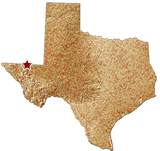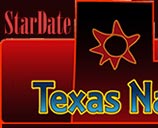|
Radio Program | Hot Well Fact Sheet | Printable version
Hot Well Pueblo
Location
Fort Bliss, northeast of El Paso
Inhabitants
- People of the Jornada Branch of the Mogollon Culture, which
covered southern New Mexico, western Texas, and northern Chihuahua
- Early farming culture, growing beans, squash, corn, and other
crops
- Inhabited around 1200-1300; region mostly abandoned by 1400,
perhaps because of severe drought
The Site
 A one-story pueblo of about 100 rooms. The structure has eroded away,
leaving only the foundations, which are buried beneath the shifting dunes.
Most of the rooms are aligned east-to-west, with doorways in the south
walls. Most rooms were built with central hearths, which probably ventilated
through holes in thatched rooms. A one-story pueblo of about 100 rooms. The structure has eroded away,
leaving only the foundations, which are buried beneath the shifting dunes.
Most of the rooms are aligned east-to-west, with doorways in the south
walls. Most rooms were built with central hearths, which probably ventilated
through holes in thatched rooms.
Several other pueblos, all of which were inhabited at around the same
time, have been discovered in the El Paso region as well.
Astronomical Significance
A room designated Room One is different from the other rooms at Hot Well.
It opens to the east, and its hearth is raised. The hearth also is decorated
with a possible Sun symbol. Some archaeologists hypothesize that the room
served as a solar observatory, because on the dates of the equinoxes,
an observer sitting behind the hearth would see the Sun rise directly
above the hearth through a notch in the nearby Hueco mountains. Sunrise
on the summer and winter solstices could be observed by standing in the
corners of the room and looking above the hearth.
Many other pueblo cultures have had designated “sunwatchers” to
track the Sun’s annual motion across the horizon. In the case of
Hot Well, the typical date of the last freeze is around the time of the
spring equinox, so knowing when the equinox occurred could have told the
inhabitants that it was safe to plant their crops.
Public Access
Because Hot Well is on a military site, it is not accessible to the public.
The people of Hot Well and other pueblos probably hunted and gathered
water, and may have painted glyphs, at nearby Hueco Tanks State Historic
Site, 6900 Hueco Tanks Rd.
#1, El Paso, 79938, 915-857-1135. The park is located off US 62/180 24
miles east of El Paso, then 8 miles north on FM 2775. Daily guided rock-art
tours are offered by reservation. Hueco Tanks is open Wednesday-Sunday,
but access is limited.
Exhibits on local Indian cultures are available at the El Paso Museum
of Archaeology at Wilderness Park [www.epas.com/museum.htm], 4301 Transmountain
Rd., El Paso, 79924, 915-755-4332. Hours: 9-5 Tuesday-Saturday. Free admission
(donations welcome).
References, Resources
An El Paso Astronomical Observatory, by Vernon Ralph Brook,
in Jornada Mogollon Archaeology, Patrick H. Beckett and Regge N. Wiseman,
editors, 1979.
Learn about...Texas Indians, by Georg Zappler; Texas Parks & Wildlife
Press, 1996.
A learning and activity book for children.
The Indians of Texas: From Prehistoric to Modern Times, by W.W. Newcomb
Jr.; the University of Texas Press, 1961, reprinted 2002.
Texas Beyond History: Firecracker Pueblo
Information on another Jornada Mogollon pueblo near El Paso
|
|
|
 |



